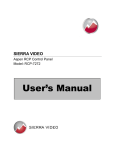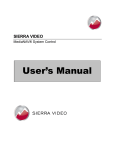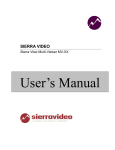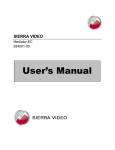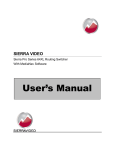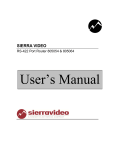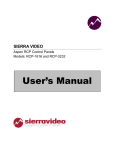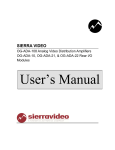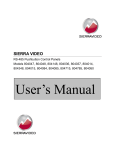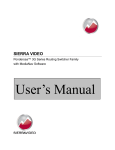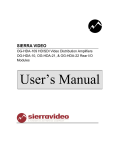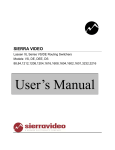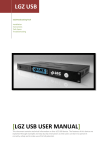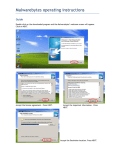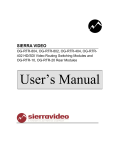Download User`s Manual - Sierra Video
Transcript
SIERRA VIDEO Aspen HD/SDI 3G Routing Switcher Models: 3232HD-3G, 1616HD-3G User’s Manual ASPEN HD/SDI 3G ROUTING SWITCHER User’s Manual Sierra Video P.O. Box 2462 Grass Valley, CA 95945 Tel: (530) 478-1000 Fax: (530) 478-1105 Email: [email protected] Version 4.0 Publication Date: July 2012 The information contained in this manual is subject to change by Sierra Video Regulatory Warnings & Safety Information The information in the following section provides important warnings and safety guidelines for both the operator and service personnel. Specific warnings and cautions may be found throughout this manual. Please read and follow the important safety precautions noting especially those instructions relating to risk of fire, electrical shock and injury to persons. Any instructions in this manual that require opening the equipment cover or enclosure are intended for use by qualified service personnel only. To reduce the risk of electrical shock, do not perform any servicing other than what is contained in the operating instructions unless you are qualified. Warnings Heed all warnings on the unit and in the operating instructions. Disconnect AC power before installing or removing device or servicing unit. Do not use this product in or near water. This product is grounded through the grounding conductor of the power cord. To avoid electrical shock, plug the power cord into a properly wired receptacle before connecting inputs or outputs. Route power cords and other cables so that they are not likely to be damaged, or create a hazard. Dangerous voltages exist at several points in this product. To avoid personal injury, do not touch unsafe connections and components when the power is on. Have qualified personnel perform safety checks after any completed service. To reduce risk of electrical shock, be certain to plug each power supply cord into a separate branch circuit employing a separate service ground. If equipped with redundant power, this unit has two power cords. To reduce the risk of electrical shock, disconnect both power cords before servicing. Operate only with covers and enclosure panels in place – Do Not operate this product when covers or enclosure panels are removed. This is an FCC class A product. In a domestic environment, this product may cause radio interference, in which case the user may be required to take necessary measures. Use the proper AC voltage to supply power to the switcher. When installing equipment, do not attach the power cord to building surfaces. Cautions SIERRA VIDEO Cautions (continued) Use only the recommended interconnect cables to connect the switcher to other frames. Follow static precautions at all times when handling the equipment. Power this product only as described in the installation section of this manual. Leave the sides of the frame clear for air convection cooling and to allow room for cabling. Slot and openings in the frame are provided for ventilation and should not be blocked. Only an authorized Sierra Video technician should service the switchers. Any user who makes changes or modifications to the unit without the expressed approval of Sierra Video will void the warranty. If installed in a closed or multi-unit rack assembly, the operating ambient temperature of the rack environment may be greater than the room ambient temperature. Therefore, consideration should be given to installing the equipment in an environment compatible with the manufacturer’s maximum rated ambient temperature (TMRA). Installation of the equipment in a rack should be such that the amount of air flow required for safe operation of the equipment is not compromised. Other connections between peripherals of this equipment may be made with low voltage non-shielded computer data cables. Network connections may consist of non-shielded CAT 5 cable. Do not cover chassis ventilation slots or block enclosure openings. FCC Notice This equipment has been tested and found to comply with the limits for a Class A digital device, pursuant to Part 15 of the FCC rules. These limits are designed to provide reasonable protection against harmful interference when the equipment is operated in a commercial environment. This equipment generates, uses, and can radiate radio frequency energy and, if not installed and used in accordance with the instruction manual, may cause harmful interference to radio communications. Operation of this equipment in a residential area is likely to cause harmful interference in which case the user will be required to correct the interference at the expense of the user. The user may find the following publication prepared by the Federal Communications Commission helpful: “How to Identify and Resolve Radio-TV Interference Problems” (Stock number 004-000-00345-4). Available exclusively from the Superintendent of Documents, Government Printing Office, Washington, DC 20402 (telephone 202 512-1800). Warning Changes or modifications not expressly approved by the party responsible for compliance to Part 15 of the FCC Rules could void the user’s authority to operate the equipment. SIERRA VIDEO Power Supply Cords Use only power cord(s) supplied with the unit. If power cord(s) were not supplied with the unit, select as follows: For units installed in the USA and Canada: select a flexible, three-conductor power cord that is UL listed and CSA certified, with individual conductor wire size of #18 AWG, and a maximum length of 4.5 meters. The power cord terminations should be NEMA Type 5-15P (three-prong earthing) at one end and IEC appliance inlet coupler at the other end. Any of the following types of power cords are acceptable; SV, SVE, SVO, SVT, SVTO, SVTOO, S, SE, SO, SOO, ST, STO, STOO, SJ, SJE, SJO, SJOO, SJT, SJTOO, SP-3, G, W. For units installed in all other countries; select only a flexible, three-conductor power cord, approved by the cognizant safety organization of your country. The power cord must be Type HAR (Harmonized), with individual conductor wire size of 0.75 mm². The power cord terminations should be a suitably rated earthing-type plug at one end and IEC appliance inlet coupler at the other end. Both of the power cord terminations must carry the certification label (mark) of the cognizant safety organization of your country. A non-shielded power cord may be used to connect AC power to every component and peripheral of the system. Connect an external 16 AWG or larger wire from earth ground to the chassis of the system as designated by the earth ground symbol. North American Power Supply Cords This equipment is supplied with North American power cords with molded grounded plug (NEMA15P) at one end and molded grounding connector (IEC 320-C13) at the other end. Conductors are CEE color coded, light blue(neutral), brown(line), and green/yellow(ground). Operation of the equipment at voltages exceeding 130VAC will require power supply cords that comply with NEMA configurations. International Power Supply Cords If shipped outside North America, this equipment is supplied with molded ground connector (IEC 320-C13) at one end and stripped connectors (50/5mm) at the other end. Connections are CEE color coded, light blue (neutral), brown(line), and green/yellow(ground). Other IEC 320-C13 type power cords can be used if they comply with safety regulations of the country in which they are installed. EMC Regulatory Notices Federal Communications Commission (FCC) Part 15 Information: This device complies with Part 15 of the FCC standard rules. Operation is subject to the following conditions: This device may not cause harmful interference This device must accept any interference received including interference that may cause undesirable operations. Delivery Damage Inspection Carefully inspect the frame and exterior components to be sure that there has been no shipping damage. 3 Table of Contents Overview Aspen HD/SDI 3G Model 3232HD 3G Model 1616HD 3G 1 1 2 2 Installation Introduction Dimensions Connecting To Video Devices Connecting Peripherals Reference Connector AC Power Connections Multi-Frame Systems Serial Cable Connections 3 3 3 4 4 4 5 5 5 Configuration Ethernet Setup Change Network Parameters Change Serial Port Settings Mode Names Salvos Overview Salvo Setup Advanced System Information Inputs Input Equalizers Output Reclockers Reference Settings Reference Formats Layers Dual Link Mode GUI Panel Button Brightness Button Settings Alerts Changing Password Software Updates Factory Defaults 7 7 9 10 10 11 12 12 12 13 13 14 14 16 18 19 20 21 22 24 25 27 28 29 30 Operation Introduction Web Page Switching the Routing switcher V and A Buttons Destination based Switching Break-away Switching Source based Switching Salvo Local Control Panel Operation Switching the Routing switcher V and A Buttons Destination based Switching Break-away Switching Source based Switching Lock Button Lamp Test Salvo Setup Functions Return to Factory Default IP Address Button Brightness Power Saving Mode Error Indications Control via 9-pin Connectors Control via Ethernet 31 31 31 32 32 32 32 33 33 34 35 35 35 35 36 36 37 38 39 39 39 41 42 42 43 43 HOST Protocol Introduction Command Summary Commonly Used Switching Commands 45 45 47 52 Troubleshooting Introduction Button Lamp Test Front Panel Error Indications Technical Support 53 53 53 53 55 Specifications 57 Warranty 59 Contents - 1 SIERRA VIDEO 1 Chapter Overview Aspen HD/SDI 3G Introduction The Sierra Video Aspen HD-3G Series routing switchers are compact units offering digital video boards that work with SDI video SMPTE 259M-C, HD SMPTE 292M, and 3G SMPTE 424M. These unique routing switchers can also route DVB-ASI signals. Some routers in the Aspen HD/SDI series come with a standard front local control panel. Remote control is also available using an RS-232/422 serial interface or an Ethernet port. This manual covers the1616 and 3232 routers in the Aspen Series of HD/SDI routing switchers. The HD/SDI series accommodates, audio follow video (AFV), or breakaway (split) routing. Model Suffix Designations Model Suffix Designations 3232, 1616 Routing Switcher size HD Multi-format HD/SDI Digital Video 1 SIERRA VIDEO Model 3232HD 3G Frame Front Panel Frame Back Panel Side Model 1616HD 3G Frame Front Panel Frame Back Panel 2 SIERRA VIDEO 2 Chapter Installation Introduction Installation procedures are similar for all frames covered under this manual. Exceptions, if any, have been noted in each of the following paragraphs. Rack Mounting Carefully inspect the frame to ensure that there has been no shipping damage. Make sure all shipping material is removed from the routing switcher frame. The routing switcher described in this manual can be rack mounted in a standard 19" (RU) EIA rack assembly and includes rack "ears" at the ends of the front of the frames. It does not require spacing above or below the unit for ventilation. To rack mount any of the routing switchers, simply place the unit's rack ears against the rack rails of the rack, and insert proper rack screws through each of the holes in the rack ears. Always rack mount the routing switcher prior to plugging the unit into a power receptacle or attaching any cables. CAUTION! The operating temperature range of this product is 0 to 40ºC. Do not exceed the maximum (40ºC) or minimum (0ºC) operating temperature. If installed in a closed or multi-rack assembly, the operating ambient temperature of the rack environment may be greater than the room ambient temperature. Therefore, consideration should be given to installing the equipment in an environment compatible with the manufacturer’s maximum rated ambient temperature. Installation of the equipment in a rack should be such that the amount of air flow to the sides of the routing switcher required for safe operation of the equipment is not compromised. Dimensions Aspen 3232 Series HD-3G Routing switcher frame is 2 rack units high, 19” wide, and 2” deep. Aspen 1616 Series HD-3G Routing switcher frame is 1 rack unit high, 19” wide, and 2” deep. 3 SIERRA VIDEO Connecting To Video Devices Video sources and output devices (such as monitors, or recorders) may be connected to the routing switchers through the BNC type connectors located on the back of the unit. Keep in mind that the output signal format will be that of the input signal format. To ensure the highest quality of video routing and switching, special attention should be paid to cables and connectors. Connecting Peripherals Control panels, video reference inputs, and power are all connected to the rear of the frame. The peripherals area may vary depending on the model size and type. RS-232/422 Control connector 10/100 Base T Ethernet Connector Looping Video Referencing Inputs Ground Lug Primary Power Connection Redundant Power Connection (Optional) Reference Connector There are two BNC connectors labeled "VID REF". This is a "looping" input for SMPTE analog video referencing. Connect composite, or tri-level sync to either BNC. If desired, use the second BNC to loop the signal to another device. If the loop is not used, terminate the second BNC with 75 ohms. If a video reference signal is connected, switching will occur during the vertical interval of the reference per SMPTE RP-168 and the supported video format standards shown on page 19. If no reference signal is available, the routing switcher will switch at a random point rather than during the vertical interval of the reference signal. 4 ASPEN 1616 AND 3232HD/SDI 3G ROUTING SWITCHER AC Power Connections Aspen routing switchers offer optional redundant power supplies. The redundant power supply must be ordered seperately. The power supplies have universal AC inputs 100VAC- 240VAC. Voltage selection is not necessary because the power supply senses the correct AC input automatically. The primary and optional redundant power supplies are external AC to DC converters. Connect an external 16 AWG or larger wire from earth ground to the chassis of the system as designated by the earth ground symbol. CAUTION! Only an authorized Sierra Video technician can service the switchers. Any user who makes changes or modifications to the unit without the expressed approval of the manufacturer will void the warranty Use the proper AC voltage to supply power to the switcher. Use only the factory provided AC-DC desktop power supply to supply power to the switcher. Use only the recommended interconnect cables to connect the switcher to other frames. Multi-Frame Systems When controlling an external routing switcher via the 9-pin serial connection, a serial cable is required. Check the pin-out on both devices to verify the cable needed. The serial cable is not supplied. In the example below, the Aspen is connected to a Lassen routing switcher. In this case a null-model cable is needed. The null-modem cable is not supplied. Aspen 1616HD 3G RS-232/422 Lassen 1616S (Stereo Analog Audio) 9-Pin Null-Modem Cable (Not Supplied) RS-232/422 Serial Cable Connections Serial cable wiring for connection to external routing switcher frames is as follows; For Yosemite Audio, Lassen, Sierra Pro, Sierra Pro 64, Ponderosa & Viper (except Sierra Pro series 32) use the following pin-outs. Aspen RTR 2 RX 3 TX 3 TX 2 TX 5 GND 5 GND 5 SIERRA VIDEO For Yosemite Video, Sequoia, 3RU RS-422 Port Router, & Sierra Pro series 32 use the following pin-outs. Aspen RTR 2 RX 3 TX 3 TX 2 TX 5 GND 1,5 & 9 GND For RS422 use the following pin-outs. RS-422 Crossover Aspen 1 2 3 4 5 6 7 8 9 6 Ground Transmit (-) Receive (+) Not used Not used Not used Transmit (+) Receive (-) Ground RTR 1 8 7 4 5 6 3 2 9 Ground Receive (-) Transmit (+) Not used Not used Not used Receive (+) Transmit (-) Ground SIERRA VIDEO 3 Chapter Configuration Ethernet Setup Default IP settings; IP Address- 192.168.1.200 Subnet mask- 255.255.255.0 Gateway IP Address- 0.0.0.0 Telnet Port- 10001 To configure the IP port, the routing switcher must first be connected to your PC. This can be done by connecting an Ethernet cable (RJ45) between your PC and the routing switcher directly, or the routing switcher may be added to your existing LAN network. The routing switcher defaults to an IP address of 192.168.1.200 which will not conflict with other devices in most systems. If there is an IP address conflict, direct connection must be used to configure the routing switchers Ethernet port. The IP Address can also be changed from the front panel (See the chapter on “Operation” for details.) Once your PC and the routing switcher are on the same Ethernet network, open your internet browser and type in the default address of the routing switcher in the address line of the internet browser. This will open a web page generated by the routing switcher. Routing switcher information is displayed on this page. 7 SIERRA VIDEO Note: The “Operate” tab is discussed in Chapter 4 “Operation”. You must login to Set or modify Routing switcher parameters. To login, select the login button. Enter the password and select “Login”. Note: The factory default password is “password”. To change the password see the section “Changing Password” at the end of this chapter. After a successful login, you will be provided with additional tabs as shown below. The “refresh” button will re-read the current settings in the routing switcher. 8 ASPEN 1616 AND 3232HD/SDI 3G ROUTING SWITCHER Change Network Parameters To make changes to the network communications (i.e. IP address), select the “Network” tab. The front panel has the ability to change the network address. If you wish to disable this function, remove the check from the box “Allow Network Settings to be changed from the front panel”. The “refresh” button will re-read the current settings in the routing switcher. Make any changes necessary and press “Save” to implement changes. Note: Changing any parameters in this window will cause your browser to lose communication with the routing switcher. You must enter the new IP address in your browser to re-establish communications. Routing switcher need not be reset for changes to take effect. DHCP is not supported. 9 SIERRA VIDEO Change Serial Port Settings To make changes to the serial port settings (i.e. Baud Rate), select the “Serial” tab. The “refresh” button will re-read the current settings in the routing switcher. Make any changes necessary and press “Save” to implement changes. Note: Routing switcher must be reset for changes to take effect. You will be prompted to reset the routing switcher. If you do not reset the routing switcher at this time you must remember to do so later by removing and re-applying the power. *When controlling an external routing switcher the 9-pin serial connection must be a “null modem” cable. Mode The serial port has two mode settings, “Master” and “Slave”. In the “Master” mode the serial port is used to control external devices (layers). In the “Slave” mode the routing switcher can be controlled via the serial port by an external device (i.e. automation) and set to respond to either Sierra Video or Kramer protocol. With Sierra Video protocol, you can choose to have the router acknowledge commands (Respond Always), or to be silent (Respond Never). 10 ASPEN 1616 AND 3232HD/SDI 3G ROUTING SWITCHER Names To change names of any of the sources, destinations, levels, select the “Names” tab. Click on the cell you want to change and type in a new name. Make any changes necessary and press “Save” to implement changes. Note: The routing switcher’s name is limited to 20 characters, other names are limited to 8 characters. 11 SIERRA VIDEO Salvos Overview A Salvo is a list of crosspoint switches that are saved in the routing switcher and switched by a single “Salvo Take” command or from a salvo button on the front panel. Up to 16 Salvos are stored in the routing switcher. To make and name salvos, select the “Salvo” tab. Salvo Setup To program a salvo, select a salvo number from the dropdown list. This number is the input button number, on the front panel, where the salvo will be stored and fired. Enter a name (not required). Enter the desired Input/Output combinations. Select an “Action” (“Take” switches the selected layer and “Take All” switches all layers). Click on the “Add Above” or “Add Below” button (“Add Above will put the entry on the top of the list and “Add Below will put the entry at the bottom of the list). Each salvo has a maximum of 32 steps/actions on the Aspen 3232-HD and 16 on the Aspen 1616-3G. The “refresh” button will re-read the current salvos in the routing switcher. Make any changes necessary and press “Save Salvo” to program the Salvo. 12 ASPEN 1616 AND 3232HD/SDI 3G ROUTING SWITCHER Advanced The “Advanced” tab allows access to “engineering” settings such as input EQ, output reclockers, routing switcher expansion, etc. Clicking on the bars on the lefthand side of the screen gives access to adjustments and status. System Information The “System Information” tab provides an overview of the system status and current configuration settings of the routing switcher. If external layers are configured, their status will be displayed on this screen. 13 SIERRA VIDEO Inputs Select “Inputs” for access to cable equalizer adjustments and input signal status. This screen will status input signal presence and signal type. Input Equalizers To set or change a single input equalizer, enter the input number, select the equalizer mode from the drop down menu and press “Apply to Input”. To set or change all input equalizers, select the equalizer mode and press “Apply to All Inputs”. The factory recommended mode is “ON” 14 ASPEN 1616 AND 3232HD/SDI 3G ROUTING SWITCHER If a valid input signal is detected, it will be indicated as “Present”. The “Rate” column indicates the signal type detected at the input. If the input is missing, the rate will be “Unknown”. Note: If the signals you are connecting to the Aspen routing switcher inputs have a bit rate < 125Mbps, you may want to set the Equalizer mode to Bypass if you find you have bit errors in the video. This should not be a requirement for most low bit-rate signals. Warning! Changes to this screen could adversely affect operation of the routing switcher. 15 SIERRA VIDEO Output Reclockers Select “Output Reclockers” for access to reclocker adjustments and status. This screen will report the reclocker status and allow you to set the reclocker mode. To set the reclocker mode of a single output, enter the output number, select the reclocker mode from the dropdown list and press “Apply to Output”. To set the reclocker mode of all outputs, select the reclocker mode from the dropdown list and press “Apply to All Outputs”. There are five states for the Reclocking Mode; 16 Auto- Factory recommended mode Bypass SD HD (1.5G) 3G ASPEN 1616 AND 3232HD/SDI 3G ROUTING SWITCHER The “Reclocker State” column indicates if the output reclockers are locked. Warning! Changes to this screen could effect operation of the routing switcher. 17 SIERRA VIDEO Reference Settings This screen is for reporting status and setting the video reference input parameters allowing the video to switch at the correct point for “seamless” switching per SMPTE RP168. If no reference signal is available or the “Use video reference” box is not checked, the routing switcher will switch at a random point rather than during the correct line (vertical interval) of the SDI input signal. Selecting “Auto based on reference”, the reference input will automatically be detected and the routing switcher will switch based on the signal type applied to the reference input. The routing switcher will switch during vertical interval as indicated by the detected referrence input. Selecting “Manual” allows you to manually select the video format of the signals passing through the routing switcher. 18 ASPEN 1616 AND 3232HD/SDI 3G ROUTING SWITCHER Reference Formats Video Reference NTSC (59.94Hz) PAL (50 Hz) [email protected] (Tri-Level Sync) 1080i@50Hz (Tri-Level Sync) [email protected] (Tri-Level Sync) 720p@50Hz (Tri-Level Sync) [email protected] (Tri-Level Sync) 1080p@50Hz (Tri-Level Sync) Supported video formats [email protected] [email protected] [email protected] [email protected] SD@50Hz 1080i@50Hz 720p@50Hz 1080p@50Hz [email protected] [email protected] [email protected] [email protected] SD@50Hz 1080i@50Hz 720p@50Hz 1080p@50Hz [email protected] [email protected] 720p@50Hz 1080p@50Hz [email protected] [email protected] 720p@50Hz 1080p@50Hz Comments SD-SDI at 59.94Hz frame rate per SMPTE 259M-C (270Mbps) HD-SDI @1080i5994 HD-SDI @720p5994 3G-SDI @1080p5994 SD-SDI at 50Hz frame rate per SMPTE 259M-C (270Mbps) HD-SDI @1080i50 HD-SDI @ 720p50 3G-SDI @1080p50 SD-SDI at 59.94Hz frame rate per SMPTE 259M-C (270Mbps) HD-SDI @1080i5994 HD-SDI @720p5994 3G-SDI @1080p5994 SD-SDI at 50Hz frame rate per SMPTE 259M-C (270Mbps) HD-SDI @1080i50 HD-SDI @ 720p50 3G-SDI @1080p50 HD-SDI @ 720p5994 3G-SDI @1080p5994 HD-SDI @ 720p50 3G-SDI @1080p50 HD-SDI @ 720p5994 3G-SDI @1080p5994 HD-SDI @ 720p50 3G-SDI @1080p50 Note: In the table above, the default video format for each reference is marked in bold. 19 SIERRA VIDEO Layers The “Layers” screen is used for adding external devices (Layers) to the existing routing switcher. The “refresh” button will re-read the current settings in the routing switcher. Make any changes necessary and press “Save” to implement changes. Enter the number of external layers you want to add and press “Apply”. Select the correct layer type from the dropdown list. The “Video/Audio” selection determins whether the “A” or “V” button on the front panel will control the level. Control Type can be Serial or Ethernet. Note: To control external layers over Serial, the routing switcher must be set to “Master” mode (see “Serial” tab). 20 ASPEN 1616 AND 3232HD/SDI 3G ROUTING SWITCHER Dual Link Mode To set the routing switcher in the Dual Link mode, place a check in the “Dual Link Mode” box. When the Aspen 3232 is set in the dual link mode, it becomes a 16x16 (8x8 for the 1616 model) with 2 BNC connectors per input and output. BNC connectors for input and outputs in the dual link mode are as follows; Input Input Button #s Connector #s 1 1-2 2 3-4 3 5-6 4 7-8 5 9-10 6 11-12 7 13-14 8 15-16 9 17-18 10 19-20 11 21-22 12 23-24 13 25-26 14 27-28 15 29-30 16 31-32 Output Button #s 1 2 3 4 5 6 7 8 9 10 11 12 13 14 15 16 Output Connector #s 1-2 3-4 5-6 7-8 9-10 11-12 13-14 15-16 17-18 19-20 21-22 23-24 25-26 27-28 29-30 31-32 21 SIERRA VIDEO GUI Panel The GUI Panel is the switching panel that appears when the “Operate” tab is selected (see operation details in the next chapter). The GUI switching panel can be enabled or disabled by placing a check in the box or not. Status polling time can also be set on this page. 22 ASPEN 1616 AND 3232HD/SDI 3G ROUTING SWITCHER The GUI switching panel can be set for “Auto Take” mode. In the “Auto Take” mode, the routing switcher switches as soon a destination and source are selected (or a source and destination are selected if “Enable Source Based Switching” is selected (see below). Source based switching allows for a source to be selected first followed by selecting a destination or multiple destinations. The factory default setting is Destination Based switching where the destination is selected first followed by selecting a source (box unchecked). 23 SIERRA VIDEO Button Brightness The “button brightness” tab sets the brightness of the front control panel buttons. Button Brightness- The button brightness can be set to 16 different levels. Power Saver Mode- When the Power Saver mode is enabled, the buttons will dim to 25% of the set brightness at the specified “wait” time. 24 ASPEN 1616 AND 3232HD/SDI 3G ROUTING SWITCHER Button Settings The “button Settings” tab sets lock, and “Take” mode parameters of the front control panel buttons. The control panel can be set for “Auto Take” mode. In the “Auto Take” mode, the routing switcher switches as soon a destination and source are selected (or a source and destination are selected if “Enable Source Based Switching” is selected (see below). Source based switching allows for a source to be selected first followed by selecting a destination or multiple destinations. The factory default setting is Destination Based switching where the destination is selected first followed by selecting a source (box unchecked). 25 SIERRA VIDEO Lock Button Mode- The “Lock” button on the front panel can disable front panel operation. There are 4 modes of operation for this button; 1. Disabled- Panel cannot be locked. In this mode, the Lock button disabled and is always off. 2. Enabled- Panel can be locked. The button toggles on/off when pressed. In this mode the button will be RED when the panel is locked. 3. Always locked show status- Panel is always locked. Output buttons can be selected and the current input connected to that output will light. The lock button is disabled and always on. In this mode the button will be PURPLE. 4. Always locked no status- Panel is always locked and will not show status if an output is selected. In this mode the button will be PURPLE and all other buttons on the panel will be off. The “refresh” button will re-read the current settings in the routing switcher. Make any changes necessary and press “Save” to implement changes. The router will need to be reset for these changes to take effect. 26 ASPEN 1616 AND 3232HD/SDI 3G ROUTING SWITCHER Alerts For systems with redundant power supplies, the front panel buttons can be set to alert you to a power supply failure by blinking the lock button. This is set from the screen below. Note: If you do not have redundant power supplies, make sure the box is not checked 27 SIERRA VIDEO Changing Password To change the password, or if you forgot your password, select “reset it” from the login screen. Enter the new password, serial number of the unit and press “Save”. The password can also be changed from the “Advanced” tab (without entering the serial number). 28 ASPEN 1616 AND 3232HD/SDI 3G ROUTING SWITCHER Software Updates From time to time software upgrades may be available from Sierra Video. Check our web site sierravideo.com for available downloads, or contact the factory. Place the software update file on your computer and select browse to locate the file. Press “Update Software” and progress status will display. Note: The routing switcher will reset to complete the update. 29 SIERRA VIDEO Factory Defaults This screen allows you to reset the routing switcher to the factory default settings. All routing switcher parameters are reset including the IP address. CAUTION! If you restore factory defaults, you will lose all configuration changes that you have made. 30 SIERRA VIDEO 4 Chapter Operation Introduction The purpose of a routing switcher is to switch any of the inputs (sources) to any of the outputs (destinations). Any input can be connected to any or all outputs but each output can only be connected to a single input. Control remains the most important component of your new system. The standard local control panel empowers full control of the routing switcher. External control is also available via the Ethernet or serial port. Web Page The Aspen family of routing switchers can be switched using the built-in web pages. Note: The 1616 model will have the same function buttons with only 16 input and 16 output buttons. If audio is not present, the “Audio” button will be inactive. Button Colors Take button will be blinking RED when enabled. Otherwise, it will be off. The FUNC button will be YELLOW in base operation. The LOCK button will be RED when the panel is locked.Otherwise, it will be off. The V (video levels) button will be GREEN when selected. Otherwise, it will be off. The A (audio levels) button will be BLUE when selected. Otherwise, it will be off. 31 SIERRA VIDEO Switching the Routing switcher V and A Buttons V (Video levels) button will enable the video level(s) to switch. A (Audio levels) button will enable the Audio level(s) to switch. In normal operation with at least one audio level configured: • The V button will be on by default. The A button will be on by default. • The V and A buttons will toggle on/off when pressed. In normal operation with no audio level configured: • The V button will remain on and will not respond to any selection of this button. • The A button will remain off and will not respond to any selection of this button. Destination based Switching 1. Select an output 2. Select (enable level) to be switched by toggling the “A” and “V” button.- see above 3. Select an input (In auto take mode, the switch will occur immediately.) 4. If auto take mode is not enabled the “Take” button will blink RED- press take to initiate the switch. Break-away Switching After selecting an output the “A” and “V” buttons may light indicating that both audio and video are preset to switch. Pressing the “A” or “V” button toggles the button on and off. On= enabled, Off= disabled. If video is only to be switched, press the “A” button turning it off so that only the video will switch. Note: The 1616 model will have the same function buttons with only 16 input and 16 output buttons. If audio is not present, the “Audio” button will be “greyed out”. Destination based Status When an output is selected, the input currently connected to that output will light. When video and audio(if available) are routed from the same source then only that source button lamp will be lit. Selected output button will be GREEN. Input button colors: CYAN to indicate video and audio. GREEN to indicate video only. BLUE to indicate audio only. When a crosspoint switch is initiated from a point of control other than the local pushbutton interface, AND it involves the currently selected destination, THEN the source button tallies will be updated automatically. 32 ASPEN 1616 AND 3232HD/SDI 3G ROUTING SWITCHER Source based Switching 1. Select an input 2. Select (enable level) to be switched by toggling the “A” and “V” button. 3. Select an output (. In auto take mode, the switch will occur immediately) 4. If auto take mode is not enabled the “Take” button will blink RED- press take to initiate the switch, or you can select additional outputs to preset takes for multiple outputs to the same selected source. In the latter case all selected outputs will be switched to the selected source when take is pressed. Source based Status When an input is selected, the output(s) currently connected to that input will light. Selected input button will be GREEN. Output button colors: CYAN to indicate video and audio. GREEN to indicate video only. BLUE to indicate audio only. Salvo Salvos are programmed via the web page (see the Salvo Setup Section). To fire a Salvo; Select the FUNC button. The button turns YELLOW Select the SALVO button. This button will illuminate BLUE. Buttons One (1) to Sixteen (16) in the INPUT section illuminate BLUE to indicate the programmed salvos. Select any of the illuminated input buttons. The selected button will blink CYAN. The TAKE button begins to blink red Select TAKE • The salvo is executed • The FUNC button turns off • The front panel returns to normal operation mode 33 SIERRA VIDEO Local Control Panel Operation The standard local control panel consists of, 32 inputs, 32 outputs (16 inputs, 16 outputs for the 16x16 model), a “V” (video only) button, an “A” (audio only) button, a function, a lock, and a take button. Use these features to switch between video and/or external audio, select the output and input and access special functions. Button Colors 34 Take button will be blinking RED when enabled. Otherwise, it will be off. The FUNC button will be YELLOW in base operation. The LOCK button will be RED or PURPLE when the panel is locked.Otherwise, it will be off. The V (video levels) button will be GREEN when selected. Otherwise, it will be off. The A (audio levels) button will be BLUE when selected. Otherwise, it will be off. ASPEN 1616 AND 3232HD/SDI 3G ROUTING SWITCHER Switching the Routing switcher V and A Buttons V (Video levels) button will enable the video level(s) to switch. If any configured video layer is missing (i.e. external routing switcher), the V button will blink instead of being a steady on. A (Audio levels) button will enable the Audio level(s) to switch. If any configured audio layer is missing (i.e. external routing switcher), the A button will blink instead of being a steady on. In normal operation with at least one audio level configured: • The V button will be on by default. The A button will be on by default. • The V and A buttons will toggle on/off when pressed. In normal operation with no audio level configured: • The V button will remain on and will not respond to any selection of this button. • The A button will remain off and will not respond to any selection of this button. Destination based Switching 1. Select an output 2. Select (enable level) to be switched by toggling the “A” and “V” button.- see above 3. Select an input (In auto take mode, the switch will occur immediately.) 4. If auto take mode is not enabled the “Take” button will blink RED- press take to initiate the switch. Break-away Switching After selecting an output the “A” and “V” buttons may light indicating that both audio and video are preset to switch. Pressing the “A” or “V” button toggles the button on and off. On= enabled, Off= disabled. If video is only to be switched, press the “A” button turning it off so that only the video will switch. Destination based Status When an output is selected, the input currently connected to that output will light. When video and audio(if available) are routed from the same source then only that source button lamp will be lit. Selected output button will be GREEN. Input button colors: CYAN to indicate video and audio. GREEN to indicate video only. BLUE to indicate audio only. When a crosspoint switch is initiated from a point of control other than the local pushbutton interface, AND it involves the currently selected destination, THEN the source button tallies will be updated automatically. 35 SIERRA VIDEO Source based Switching 1. Select an input 2. Select (enable level) to be switched by toggling the “A” and “V” button. 3. Select an output (. In auto take mode, the switch will occur immediately) 4. If auto take mode is not enabled the “Take” button will blink RED- press take to initiate the switch, or you can select additional outputs to preset takes for multiple outputs to the same selected source. In the latter case all selected outputs will be switched to the selected source when take is pressed. Source based Status When an input is selected, the output(s) currently connected to that input will light. Selected input button will be GREEN. Output button colors: CYAN to indicate video and audio. GREEN to indicate video only. BLUE to indicate audio only. Lock The LOCK button has 4 modes of operation. The mode can be set via the web pages. The four modes are: Panel cannot be locked. Lock button is disabled and is always off. Panel can be locked. Lock button is enabled. It goes on/off when pressed. The button will be RED when it is on. This is the default mode of operation. Panel always locked, show status. Lock button disabled and is always on. The button will be PURPLE. Output buttons can be selected and input status is shown. Panel always locked, do not show status. Lock button disabled and is always on. The button will be PURPLE. All other buttons on the panel are always off. If the panel is set to destintion based switching and the routing switcher status is allowed while in the panel lock mode (see above), the user can select any output button. The current Input connected to this output will status by illuminating. While the panel is locked: • The INPUT buttons will be disabled (nothing will happen when they are pressed). If the panel is set to source based switching and the routing switcher status is allowed while in the panel lock mode (see above), the user can select any input button. The current output(s) connected to this input will status by illuminating. While the panel is locked: • The OUTPUT buttons will be disabled (nothing will happen when they are pressed). In either mode, • The following buttons will be off and disabled (nothing will happen when they are pressed): • FUNC button • A button • V button • TAKE button 36 ASPEN 1616 AND 3232HD/SDI 3G ROUTING SWITCHER Button Lamp Test 1) On power up, press and hold input button 1 until all GREEN LEDs turn on 2) For input button 1, pressing the button will go through the following sequence a. b. c. d. e. f. g. All BLUE LEDS on All RED LEDS on All LEDs off Input button 1 GREEN LED on Input button 1 BLUE LED on All GREEN LEDs on Go back to step a. 3) For all other buttons, each press of the button will cycle through each LED supported by that button and off. If you continue to push the button, it will then repeat the sequence. For example, if input button 2 is off, pressing it will go through the following sequence. a. b. c. d. GREEN BLUE off Go back to step a. 4) To exit test mode, remove and re-apply power to the unit. 37 SIERRA VIDEO Salvo Salvos are programmed via the web page (see the Salvo Setup Section). To fire a Salvo; Select the FUNC button. The button turns YELLOW Select the SALVO button. This button will illuminate BLUE. Buttons One (1) to Sixteen (16) in the INPUT section illuminate BLUE to indicate programmed salvos. Select any of the illuminated buttons. The selected button will blink CYAN. The TAKE button begins to blink red Select TAKE • The salvo is executed • The FUNC button turns off • The front panel returns to normal operation mode Note: On the Aspen 32x32, the SALVO button is output button 25. On the Aspen 16x16, the SALVO button is output button 9. 38 ASPEN 1616 AND 3232HD/SDI 3G ROUTING SWITCHER Setup Functions Return to Factory Default To reset the routing switcher to Factory Default conditions requires simultaneous button pushes to execute the command to reset. Press and hold the FUNC until it turns BLUE, while holding the FUNC button. Press and hold Input Buttons 1 and 2. Input Buttons 1 and 2 will be BLUE. NOTE: these buttons do not light until both are held. If either button is released, both will turn off. The TAKE button blinks RED. While continuing to hold the FUNC button and Input Buttons 1 and 2, press the TAKE button to execute. Routing switcher will be reset to Factory defaults. CAUTION! All of your configuration changes in the routing switcher will be lost when you return to factory default. If you hold down button INPUT button 1 too long after hitting the TAKE button, the front panel may go into “Button Lamp Test” mode. All green LEDs will be on when this happens. To exit this mode, power cycle the routing switcher by removing and re-applying the power. Note: Releasing the FUNC button will exit the Setup mode and return the panel to its previous state. IP Address The IP address may be viewed or changed from the front panel. To display the IP address; Press and hold the FUNC until it turns BLUE. Press Output Button 26 on the Aspen 32x32 or Output Button 10 on the Aspen 16x16. This button will turn blue. • Output button 1 through 4 will turn GREEN if the IP Address can be changed from the front panel. Otherwise, these buttons will be BLUE. Press OUTPUT 1 button. This button will now blink. • Three of the INPUT buttons 1 - 10 (for 0) will turn on briefly to display the 1st octet of the IP address. Press OUTPUT 2 button. This button will now blink. • Three of the INPUT buttons 1 - 10 (for 0) will turn on briefly to display the 2nd octet of the IP address. Press OUTPUT 3 button. This button will now blink. • Three of the INPUT buttons 1 - 10 (for 0) will turn on briefly to display the 3rd octet of the IP address. Press OUTPUT 4 button. This button will now blink. • Three of the INPUT buttons 1 - 10 (for 0) will turn on briefly to display the 4th octet of the IP address. Release the FUNC button to exit. INPUT buttons 1 through 10 (for 0) will turn on their GREEN LED briefly to represent the digits of the IP Address. Buttons will turn on once for ¾ second on and ¼ second off. 39 SIERRA VIDEO 40 For example, if the IP address is 192.168.1.200 Press and hold the FUNC until it turns BLUE Press Output Button 26 on the Aspen 32x32 or Output Button 10 on the Aspen 16x16. This button will turn blue. Press OUTPUT 1 button. • Input 1 will turn on briefly • Input 9 will turn on briefly • Input 2 will turn on briefly Press OUTPUT 2 button. • Input 1 will turn on briefly • Input 6 will turn on briefly • Input 8 will turn on briefly Press OUTPUT 3 button. • Input 10 will turn on briefly • Input 10 will turn on briefly again • Input 1 will turn on briefly Press OUTPUT 4 button. • Input 2 will turn on briefly • Input 10 will turn on briefly • Input 10 will turn on briefly again To change the IP address; This only works if the operator is allowed to change the IP Address at the front panel (see “Network” in the configuration section of this manual). Press and hold the FUNC until it turns BLUE. Press Output Button 26 on the Aspen 32x32 or Output Button 10 on the Aspen 16x16. This button will turn blue. • Output button 1 through 4 will turn GREEN if the IP Address can be changed from the front panel. Otherwise, these buttons will be BLUE. Press OUTPUT 1 button. This button will now blink. • Three of the INPUT buttons 1 - 10 (for 0) will turn on briefly to display the 1st octet of the IP address. • Press 3 of the INPUT buttons 1-10 (for 0) to set the IP address for this octet of the IP address. The Take button will now blink. • Note that leading zeros are required. • The Input button will be GREEN while it is held down. • Press Take to change the IP Address. Press OUTPUT button 2. Repeat the procedure above for the 2nd octet of the IP address. Press OUTPUT button 3. Repeat the procedure above for the 2nd octet of the IP address. Press OUTPUT button 4. Repeat the procedure above for the 2nd octet of the IP address. Release the FUNC button to exit. ASPEN 1616 AND 3232HD/SDI 3G ROUTING SWITCHER For example, to set IP address is 192.168.1.251 Press and hold the FUNC until it turns BLUE. Press Output Button 26 on the Aspen 32x32 or Output Button 10 on the Aspen 16x16. This button will turn blue. Press OUTPUT 1 button • Press input 1 • Press input 9 • Press input 2. The Take button is now blinking. • Press Take Press OUTPUT 2 button • Press input 1 • Press input 6 • Press input 8. The Take button is now blinking. • Press Take Press OUTPUT 3 button • Press input 10 • Press input 10 again • Press input 1. The Take button is now blinking. • Press Take Press and hold the FUNC. Then press OUTPUT 4 button. • Press input 2 • Press input 5 • Press input 1. The Take button is now blinking. • Press Take Reset the IP address only to Factory Default To reset IP address, subnet and gateway of the routing switcher without changing any other of the routing switcher settings or conditions; Press and hold the FUNC until it turns BLUE, while holding the FUNC button. Press and hold Input Button 25 on the Aspen 32x32. (Button 9 on the Aspen 16x16) The Input Button will be BLUE. The TAKE button blinks RED. While continuing to hold the FUNC button and the input button, press the TAKE button to execute. Routing switcher will be reset to Factory IP defaults. Button Brightness To set the front panel button brightness; Press and hold the FUNC until it turns BLUE. Press the Salvo button while holding the FUNC button. Output buttons 1-8 will be green. One of the Input buttons 1 through 16 will be GREEN to indicate the current brightness setting. Press Input buttons 1 through 16 to select the brightness setting. Output buttons 1-8 will change to indicate the brightness setting. 41 SIERRA VIDEO Power Saving Mode Press and hold the FUNC button until it turns BLUE. Press the Salvo button while holding the FUNC button. The LOCK button will indicate the power saving mode. Blue if Enabled Off if Disabled Toggle the LOCK button to enable and disable. Error Indications Power Supply Failure If the system is configured for redundant power supplies and a power supply is missing, the LOCK button will blink. Routing switcher Configuration Fault If there is a serious problem with the routing switcher where it cannot operate properly, the LOCK and FUNC buttons will blink RED. All other buttons on the panel will be off. 42 ASPEN 1616 AND 3232HD/SDI 3G ROUTING SWITCHER Control via 9-pin Connectors The 9-pin connectors allow you to control the routing switcher via an external computer. The serial port can be changed internally for RS422 configuration (RS232 @ 9600 baud is factory configuration). The routing switcher has one port labeled on the back panel as “RS232/422” (refer also to the illustrations of back panels shown in Chapter 1): Connection to the RS-232/422 port is made using a standard 9 pin (pin to pin) cable. Pin RS-232 RS-422 1 Not Used Ground 2 Transmit Transmit (-) 3 Receive Receive (+) 4 Not used Not used 5 Ground Not used 6 Not used Not used 7 Not used Transmit (+) 8 Not Used Receive (-) 9 Not Used Ground NOTE: To convert the 9-pin connector to an RS422 serial port see the serial setup section. Control via Ethernet The crosspoints in the routing switcher may be controlled via Ethernet using the Host Protocol. To control the routing switcher, establish a TCP/IP connection to the IP addresses of the routing switcher using port number 10001. A communications program such as telnet can be used to establish this connection. Once the connection is established, sending the command **!! should cause the routing switcher to return ** OK !!. This connection supports the entire Sierra Video Host protocol command set supported by this model. 43 SIERRA VIDEO 5 Chapter HOST Protocol Introduction This section of this manual contains the most common Host Protocol commands. For a more detailed list of Protocol commands contact the Sierra Video factory. The protocol uses the 7-bit ASCII character set. The protocol is compact, with few characters required to cause switch changes to occur. It is also human-readable and thus easy to understand and use. All input, output, and level numbers begin at number 1, not 0. Note: When writing commands for a “third party” controller, pay careful attention to the levels of control. Commands are sent to a routing switcher in a group called a command string. A command string consists of a leader string of asterisk characters (**), zero, or more commands, and a trailer string of exclamation marks (!!). When a command string is received, it is not acted upon until the final trailer character (!) of the command string is received. Within the command string, certain ASCII characters may be present and are ignored: any ASCII character whose code is less than the SPACE character (includes all control characters and the SPACE character) and the DEL (ASCII 7F) character. Alphabetic characters within the command string may be in either upper-case or lower-case letters. The routing switcher always sends upper case characters, except for character strings such as input, output, and level names, which may have lower case characters in them. When sending commands to the routing switcher, SPACE characters are optional. SPACES may also appear in character strings, such as input, output, and level names. Certain commands have character strings that appear as arguments and use a ~ (tilda) character to delimit the character strings. The use of the tilda varies and will be defined in the individual commands. After the command string has been executed, the routing switcher sends the following to the host. **OK!! This indicates that the command has executed successfully. 45 SIERRA VIDEO The simplest possible command string would be:**!! which consists of the leader and trailer characters. This command string would generate the response: ** OK !! This can be useful for verifying that the communication to the routing switcher is operational. If an error occurs within a command string, the remainder of the command string is ignored and the routing switcher returns the string “ ERROR ", followed by an optional descriptive string followed by a string of trailer characters, to the host. The simplest error response is one with no optional descriptive string. For example, this command string: ** XXX !! might generate this response from the routing switcher: ** ERROR Syntax: No Number:XX !! 46 ASPEN 1616 AND 3232HD/SDI 3G ROUTING SWITCHER Command Summary The following is the set of commands available for sending to the routing switcher. Syntax Example Description RESET RESET Routing switcher Reset I I Capabilities Inquiry Q Q Model Name and Software Version Inquiry L L Routing Switcher Size and Level Names Inquiry N N O O5 Output Status inquiry S S Status inquiry U {0 1 2 3 4} U0 Update request on/off V out,in,in… V3,1,2,2 Connect levels X out,in,lvl X12,9,2 Connect crosspoint Y out,in Y1,7 Connect AFV T {1-16} T1 Trigger a Salvo Connect sequence G G SRC_NAMES,1,0~ The command “G” is used to query or modify a routing switcher configuration parameter or parameters. Input Status inquiry “RESET”: Routing switcher Reset When the routing switcher is powered up, the following will be sent on the serial port. **RESET!! “I”: Capabilities Inquiry The command "I" requests that command capability information be returned to the host. The information is sent as a string of characters. The first characters are a space followed by "I", the next characters are the letters of the commands that are implemented and available in this routing switcher, and the last character is "~" (tilde). Do not count on the characters being in any specific order. Search all characters for a particular one. For example, the command: **I!! might return the following string: ** ILSX~ OK !! indicating that the routing switcher supports the I, L, S, and X commands from the host. 47 SIERRA VIDEO “Q”: Model Name and Software Version Inquiry The command "Q" requests that the routing switcher model name and software version number string be returned to the host. The information is sent as a string of characters. The first characters are a space followed by "Q", the next characters are the routing switcher model name, terminated by a "~" (tilde). Following this are the characters of the software version number string, again terminated by a "~" (tilde). For example, the command: **Q!! might return the following string: ** QSmall~V2.1~ OK !!<CR> indicating that the routing switcher model name is "Small" and the software version number is "V2.1". “L”: Routing Switcher Size and Level Names Inquiry The command "L" requests that routing switcher size and level name information be returned to the host. The information is sent as a string of characters. The first characters are a space followed by "L", some optional values described below, then the number of outputs, a comma, the number of levels, a comma, the number of inputs, a comma, and then the level names, each terminated by a "~" (tilde), and the last followed by two tildes. For example, the command: **L!! might return the following string: ** L64,3,32,VIDEO~AudioL~AudioR~~ OK !! indicating that the routing switcher has 64 outputs, 3 levels, and 32 inputs, and the levels are named "VIDEO", "Audio L", and "Audio R". “N”: Source Status Inquiry The command "N" requests that status information for a single source be returned to the host. The status information is sent as one or more "Y" and/or "X" commands. For example, the command: **N4!! to a router might have the following commands as its response: ** X12,4,1 X12,4,2 X12,4,3 X13,4,4 Y23,4 !! showing that source 4 connects to 48 destination 12 on levels 1-3, destination 13 on level 4, and destination 23 on all levels. ASPEN 1616 AND 3232HD/SDI 3G ROUTING SWITCHER “O”: Output Status Inquiry The command "O" requests that the status information for a single output be returned to the host. The status information is sent as a “Y” command or a “V” command or as a sequence of L “X” commands, where L=number of levels. For example, the command: **O5!! to a 3-level routing switcher might have the following three commands as its response: ** X65,23,1 X5,-,2 X5,0,3 !! Note the dash, indicating that on level 2, output 65 is not connected to an input. Also note the 0, indicating that the connection on level 3 is either unknown or that output 65 doesn’t exist or isn’t mapped on level 3. Or, a 3-level routing switcher might have the following single command as its response: ** V65,23,-,0 !! which has the same information as the three X commands in the previous example. If the routing switcher has only one level, or if all levels are connected the same, the routing switcher might instead use the Y command. For example: ** Y65,23 !! “S”: Status Inquiry Use command “S” to request that status information be returned to the host. The status information is sent as a series of strings. For example, the command: **S!! might have the following two strings at the beginning of its response: **V1, 12!! **V2, 2!! This indicates that output 1 is connected to input 12 on level 1, and that output 2 is connected to input 2 on level 1. “U”: Update Request on/off The command "U" turns on or off the automatic sending of output change reports. The current mode can be queried with the command ** U !!. To change the setting, the command letter must be followed by either a number 0,1, 2, 3 or 4 to specify the new automatic change report state, as follows: 0: Automatic output change reporting is turned off. 1: Automatic output change reporting is turned on. Crosspoint change commands do not immediately report changed status, but instead, the report comes up to a few seconds after the crosspoint change command is received. The Aspen will send X commands when crosspoints change. 2: Automatic output change reporting is turned on, and crosspoint change commands immediately report changed status as part of the response to the command. The Aspen will send X commands when crosspoints change. 49 SIERRA VIDEO 3: Same as mode 1 except the Aspen will send V commands when crosspoints change. 4: Same as mode 2 except the Aspen will send V commands when crosspoints change. Output change reports are automatic messages sent to the host whenever an output is crosspoint status (i.e. connected source) is changed. For example, the command: **U1!! turns on automatic output change reporting. When a crosspoint is changed, the “X” command will be sent to report the change. For example: ** X5,12,2 !! indicating that output 5 is now connected to input 17 on level 1, to input 12 on level 2, and does not exist or is not available on level 3. To turn off output change reporting, use the command: **U0!! For example, suppose the routing switcher sends the following crosspoint connect commands in a single command sequence: ** Y1,18!! If U1 is in effect, the response to this command will be: ** OK !! and then sometime later, the crosspoint change report will be sent ** X1,18 !! “V”: Connect Levels The command "V" is used to request that a connection be made. It must be followed by an output number, a comma, and a comma-separated list of input numbers, one for each level. Fewer than the number of levels in the routing switchermay be specified if desired, and the remaining levels will be left unchanged. For example, the command: **V12,7,8,9!! says that connections are to be made to output 12: from input 7 on level 1, input 8 on level 2, and input 9 on level 3. An input number of 0 means the output connection is to be left unchanged. An input number of *-* (dash) means the output is to be disconnected. If the routing switcher does not support disconnected outputs, the output connection will be left unchanged. “X”: Connect Crosspoint Use command X to request that a connection be made. It must be followed by an output number, a comma, an input number, a comma, and a level number. For example: **X8, 3, 2!! This string says that a connection is to be made between output 8 and input 3 on level 2. If the level number is specified as “0”, this means that the connection is to be made on all levels (AFV). 50 ASPEN 1616 AND 3232HD/SDI 3G ROUTING SWITCHER “Y”: Connect AFV Use command Y to request that a connection be made on all levels (AFV). It must be followed by an output number, a comma, and an input number. For example, the command: **Y2, 8!! This string says that input 8 is to be connected to output 2 on all levels. “T”: Trigger a Salvo The command "T" is used to trigger a previously set up salvo. It must be followed by a register number from 1 to 256 giving the register to be triggered. For example, the command: ** T2 !! says to trigger salvo register 2. If a salvo is triggered and it fails for some reason, the salvo trigger operation is aborted, and an error is reported: For example: “ERROR Salvo Has Locked Xpts”. “G” Command Details of the “G” command can be found on our website or by contacting the factory. 51 SIERRA VIDEO Commonly Used Switching Commands This section contains the most commonly used switching commands. These commands are explained in detail in the proceeding. “Y” Command- All Levels The “Y” command switches all levels (i.e. video and audio). For example; **Y2,8!! This requests that input 8 be connected to output 2 on all levels. “X” Command- Specify Levels Using the “X” command requires that a level is specified. For example; **X8, 3, 2!! This requests that a connection is to be made between output 8 and input 3 on level 2. If a level number of “0” is used, all levels are switched. “V” Command- Connect Levels The “V” command is followed by an output number, a comma, and an input number for each level, up to the number of levels on the routing switcher. For example; **V12, 7, 8, 9!! This requests that connections are to be made to output 12 from input 7 on level 1, input 8 on level 2, and input 9 on level 3. 52 SIERRA VIDEO 6 Chapter Troubleshooting Introduction Button Lamp Test If the source one button is held down when power is first applied, the control panel will enter a Keyboard/Lamp test function. If no button is held down, the control panel will go directly to the status mode. Front Panel Error Indications Power Supply Failure If the system is configured for redundant power supplies and a power supply is missing, the LOCK button will blink. Routing switcher Configuration Fault If there is a serious problem with the routing switcher where it cannot operate properly, the LOCK and FUNC buttons will blink RED. All other buttons on the panel will be off. NOTES: If the output signal is disturbed or interrupted by electromagnetic interference, the signal should return and stabilize when the interference ends. If not, disconnect the AC power cord and reconnect it again to reset the switcher. If the following recommended actions still do not result in satisfactory operation, please consult your Sierra Video Dealer. Power and Indicators Problem No power Remedy Confirm that power connections are secured at the switcher and at the receptacle. Make sure the receptacle is active, with the proper mains voltage. 53 SIERRA VIDEO Video Signal Problem Remedy No video at the output device, regardless of input selected. Confirm that your source and destination devices are powered on and connected properly. Video signals connected to the routing switcher should have a video supported format supported by your video monitor or other destination connected to the routing switcher output. Confirm that any other switchers in the signal path have the proper input and/or output selected. Use a Video Tester to test the video path leading to/from your Routing Switcher. . Routing switcher takes are not “seamless” switching Verify that the video reference is terminated with a 75 ohm impedance. Verify that the video reference is only terminated one time, and that the termination is at the last piece of equipment in the video reference loop thru chain. Confirm that the connecting cables are of high quality and not damaged. Ensure you have selected the correct, supported SDI format for the video reference you have connected to the routing switcher. Check that your video signal matches the SDI format you have selected to provide “seamless” switching with the video reference format you have connected to the routing switcher. Check that the video reference is the format you have selected for “seamless” switching. Check that the SDI sources connected to the routing switcher inputs are vertically locked to the video reference connected to the routing switcher. 54 ASPEN 1616 AND 3232HD/SDI 3G ROUTING SWITCHER Control Problem Remedy No control of Routing Switcher from PC software Confirm the correct wiring of the connecting cable. Be sure to use a standard one to one 9 pin serial cable. Confirm that the baud rate of your computer COM port is set to the same as that of your Routing Switcher (9600-Baud factory default). Confirm that the proper COM port is selected in the control software. Use a terminal emulator program to send **!! commands and check for **OK!! response. If you do not receive **OK!!, the problem is with the switcher. Switching Malfunctions Problem The switcher succeeds in switching a number of sources then fails to switch one. Remedy Malfunction in the particular source or cable assembly. NOTE: The most common failure mode in transferring the signal of an audio source is a break in the connecting wire. Disconnect the source from a channel that is switching successfully and connect the suspect source to it. If the channel continues to switch successfully, then there is something wrong with the Routing Switcher or the suspect source was not connected properly. If it does not continue to switch successfully, then there is something wrong with the source or cable assembly. Technical Support Sierra Video has made every effort to insure that your unit has been fully tested and is configured to your order specifications. If problems arise that can not be resolved, please contact the Sierra Video technical support department. Sierra Video factory- (530) 478-1000 Email- [email protected] 55 SIERRA VIDEO 7 Chapter Specifications Video Data rates 19Mbps to 2.97 Gbps Data types SMPTE 259M-C, SMPTE 292, SMPTE 424M, DVB-ASI Input cable equalization range (Belden 1694A) 3G, 0 – 155 meters HD, 0 – 200 meters SD, 0 – 400 meters Input return loss ≥15db@ 1.485Gps, ≥10db@ 2.97Gbps Output level 800 mV p-p +/- 10% Output timing jitter SMPTE 424M ≤ 2.0UI SMPTE 292 ≤ 1.0UI SMPTE 259M-C ≤ 0.2UI Output alignment jitter SMPTE 424M ≤ 0.3UI SMPTE 292 ≤ 0.2UI SMPTE 259M-C ≤ 0.2UI Output return loss ≥15db@ 1.485Gps, ≥10db@ 2.97Gbps Mechanical I/O connectors 75 Ohm BNC Operating Temperature 0c – 40c (32F – 104F) Dimensions 3.5 (89mm) x 19.0 (483mm) x 2.5 (64mm) Weight 4.0 lbs (1.8 kg) Electrical AC Input Range 100-240V, 50-60Hz Power 3232HD-3G: 30W 1616HD-3G: 18W 57 SIERRA VIDEO Communication 58 Ethernet (1) 10/100 Base-T (RJ45) Serial Port (1) RS-232/422 (DB-9) SIERRA VIDEO 8 Chapter Warranty A. General Buyer assumes all responsibility for ascertaining the suitability of Sierra Video (hereinafter "SVS") products for Buyer's intended use. No product sold by SVS is designed or manufactured for use in any manner or under any conditions other than those described in SVS's instruction manuals and other printed material for each particular product. If any product is used or applied in a manner or under conditions not specifically authorized by such written materials or if any product is used by unqualified or improperly trained personnel, Buyer agrees that SVS shall have no liability of any kind arising from such use, and Buyer agrees to indemnify and hold SVS harmless from any claims of third parties arising from such use, and Buyer shall provide SVS with counsel of SVS's choice to defend against such claims. B. Limited Warranty 1. This limited warranty applies only to the original purchaser and is non-transferable.This limited warranty begins on the date of purchase and will be in effect for seven (7) years for new equipment and for three (3) years for "Factory Refurbished" equipment. Power Supplies and fans are warranteed for three (3) years from the date of purchase for new equipment and two (2) years for “Factory Refurbished” units, from the date of purchase. Buyer must obtain a Return Material Authorization ("RMA") number from SVS prior to returning a product for repair. If, in SVS' sole discretion, the product is found to be defective during the term of this warranty, SVS will at its option: (a) provide free replacement parts, and/or (b) repair the unit at an SVS facility. During the warranty period, SVS will make every reasonable effort to support critical emergencies by supplying no-cost loan equipment while the defective unit is being repaired. SVS will provide replacement parts and/or factory service at no charge. Buyer bears the cost of shipping products returned to SVS under this warranty. SVS will bear the cost of shipping repaired products or replacement parts to the Buyer. This limited warranty shall not apply to any of SVS's goods which have been altered or which have been subjected to misuse, mishandling, improper storage or negligence. The aforementioned provisions do not extend the original warranty period of any goods which have been replaced by SVS. This limited warranty shall not apply to any goods not of SVS's manufacture, Buyer to be entitled only to the warranty set forth in the original manufacturer's limited warranty. 59 THIS LIMITED WARRANTY IS EXPRESSED IN LIEU OF ALL OTHER WARRANTIES, EXPRESS, IMPLIED OR STATUTORY, INCLUDING WITHOUT LIMITATION THE IMPLIED WARRANTIES OF MERCHANTABILITY AND OF FITNESS FOR A PARTICULAR PURPOSE, AND ALL OTHER OBLIGATIONS OR LIABILITIES ON SVS'S PART. SVS neither assumes nor authorizes any other person to assume for SVS any other liabilities in connection with the sale of products of its own manufacture. 2. SVS's liability hereunder on any claim of any kind, except as set forth herein for any loss, injury to person or property or damage, shall in no case exceed the price allocable to the goods which give rise to such claim. 3. In no event shall SVS be liable for any damages or injuries to person or property if any goods do not meet the above limited warranty, including, without limitation, incidental expenses or consequential or special damages, except as set forth in such limited warranty. The foregoing states the exclusive remedy of Buyer and the exclusive liability of SVS for any breach of the foregoing limited warranty. C. Cancellation Except as provided in paragraph B immediately above, all sales are final, and Buyer may cancel this order or return products only upon written consent of SVS. D. General In the event of a breach of any of the terms hereof, the non-breaching party shall be entitled to recover all of its costs, fees, and expenses, including, without limitation, reasonable attorney's fees, from the breach party incurred as a result of such breach, regardless of whether or not a suit is actually filed to enforce the terms hereof. The provision hereof shall be governed by the laws of the State of California (excluding its choice of law provisions). The headings are for convenience only and do not limit or amplify the terms and provisions hereof. In case any one or more of the provisions set forth herein shall be held to be invalid, illegal, or unenforceable in any respect, the validity, legality, and enforceability of the remaining provisions contained herein shall not in any way be affected or impaired thereby. No waiver, alteration, or modification of any of the provisions hereof shall be binding unless in writing and signed by an authorized Officer of SVS. NOTE: All products returned to SVS for service must have prior approval. Return authorization requests may be obtained from your SVS dealer. 60







































































